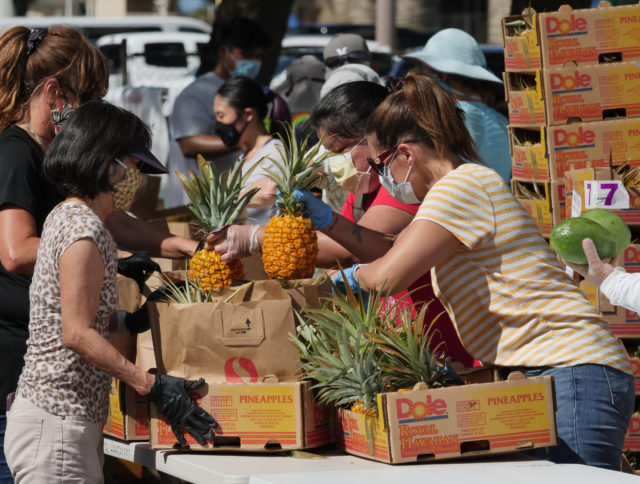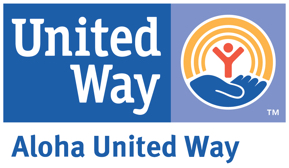
Jan. 14, 2022
Article courtesy of Honolulu Civil Beat
Personal income in Hawaii actually increased overall during the pandemic, but experts say people are going to be worse off this year as federal bailout money dries up.
Economists and community leaders are working to gather data to show what the pandemic has meant for some of Hawaii’s most vulnerable people, including those in poverty and working families who were living paycheck to paycheck before the pandemic.
Hawaii's Changinge Economy Special Project Badge
The task – which is key to enabling policymakers to target state money toward the most critical problems — is complicated because much of the data analysts typically use for such analyses is lagging and thus out of date.
Compounding the already thorny problem this year is that billions of dollars in federal aid poured into Hawaii during the pandemic creating an aberration in the data. That means the data is not only old but also distorted.
Still, one thing is clear: many people are soon likely to find themselves worse off than they were before the pandemic.
“We’re not going to be back where we would have been before the pandemic, and that’s pretty lousy for a large chunk of the population,” says Carl Bonham, executive director of the University of Hawaii Economic Research Organization.
Volunteers pack pineapples into bags to be loaded into cars at the big food distribution event held at Aloha Stadium in Honolulu, HI, Wednesday, May 6, 2020. The city of Honolulu, Hawaii Foodbank, and Hawaii Community Foundation collaborated to put on the event providing food for approximately 4,000 Oahu households. (Ronen Zilberman photo Civil Beat)
Thousands of people went to a food drive sponsored by the city of Honolulu, Hawaii Foodbank, and Hawaii Community Foundation at Aloha Stadium in May 2020. Data showing household income increased that year defies what many people experienced and saw.
Ronen Zilberman/Civil Beat
Families Were Suffering Before Pandemic
The question is how lousy are things going to be and which chunk of the population will be affected the most.
There’s little dispute many Hawaii families were struggling before the pandemic. In a landmark 2017 study, the Aloha United Way calculated a family of four in Hawaii would need just over $72,000 to cover basic living expenses, like housing, food and transportation, and to live paycheck to paycheck with little savings.
The study called families earning this subsistence income “asset limited, income constrained, employed,” or ALICE, and found that 48.5% of Hawaii families had income below the ALICE threshold.
A 2020 update indicated things could be getting worse. The Aloha United Way worked with the Hawaii Data Collaborative, which used economic modeling to try to predict what effect the pandemic was having on families. The update predicted households with ALICE income or below could grow to 59% of households because of the pandemic, although the report said state unemployment benefits and CARES Act funds “are keeping most of these households afloat for now.”
The challenge for policymakers now is that some data sources suggest the situation for families during the pandemic wasn’t that dire: something that seems to defy common sense and what many people and organizations saw.
Hawaii received approximately $8 billion in federal money to help individuals and families during the pandemic, said Jill Tokuda, a former Hawaii Senate Ways and Means Committee chair who has tracked federal stimulus payments during the pandemic. Tokuda has said she plans to run for lieutenant governor this year.
That included $2.4 billion in federal unemployment insurance money that provided people $600 a week above state payments and $686 million in pandemic unemployment assistance for self-employed people and gig workers who didn’t qualify for regular unemployment insurance.
This big influx of money appears to have created a picture that’s not useful when trying to find the community’s economic pain points. For example, the most recent available federal income data, which UHERO compiles on its data portal, shows that real personal income in Hawaii rose during the darkest days of the pandemic in 2020, even as real earnings from jobs fell. In other words, people overall had more income in 2020 than 2019 thanks to federal stimulus money – even though they weren’t working as much.
“This is not an argument,” Bonham says. “It’s just the facts.” At least according to the U.S. Bureau of Economic Analysis, Bonham adds.
The key point is that the Bureau of Economic Analysis data is limited.
“Locally we don’t measure what matters, and that’s really catching up with us now when we’re finding our reliance on these other data sources is incomplete and inadequate,” says Nick Redding, the Hawaii Data Collaborative’s executive director.
The collaborative is pivoting from focusing on public health data related to the Covid-19 pandemic to data that can help organizations working with people in need, Redding said. In some cases, he said, the data needed to guide decisions just isn’t there.
Getting a handle on the ALICE population using hard data instead of modeling, for instance, has been impossible. Redding said some leaders have said that there’s been a growth in this population since the worst days of the pandemic have passed. But there’s no timely data to show what’s going on now, he said.
Such data probably will have to come from government agencies and nonprofit groups working in the trenches, he said. Redding wants to make clear the data collaborative is neutral on potential solutions. Rather, the organization wants to help private nonprofits and government agencies better understand problems and thus solve them.
“What would help them understand it in a data-driven way?” he said.
Some Solutions Are Emerging
While the data collaborative is taking a neutral stance on policies to help struggling families, others are more outspoken.
Tokuda and others, including Bonham, say offering tax credits to help cover child care goes a long way toward helping working families. Tokuda said the state’s current earned income tax credit law possibly could be tweaked to steer money toward child care. Tokuda also suggested the credit could be made refundable and set up to provide a steady flow of monthly income to qualified families.
Tokuda said tax expenditures for child care benefit the community not only by making sure children are taken care of but also by freeing up parents to resume or continue working – both of which can have long-term benefits to families.
“The reality is going back to where we were is not acceptable.” — Former state Sen. Jill Tokuda
“The dollars that we have need to go to places that aren’t just temporary pain points, but to things that have long-term consequences,” she said.
Deja Ostrowski, a staff attorney with the Medical-Legal Partnership for Children in Hawaii, suggested money be steered to Hawaii’s Temporary Aid for Needy Families program.
There are significant sums of money for rent relief that can’t be spent simply because many landlords refuse to accept tenants who are using state funds to pay rent. In addition, she said, the rent support can be used only for rent and not expenses such as parking and utilities.
Bolstering the approximately $388 per month an individual now receives could help many people make it, she said. In addition, there’s already a system in place to distribute the money to qualified people.
“Why is not our first impulse to give more cash welfare to families that have already jumped through all these hoops when our cash welfare is so low?” she said. “And these are working families.”
Regardless of how the money is spent, Tokuda said things in 2022 need to be different than they were in 2019.
“The reality is going back to where we were is not acceptable,” she said.
